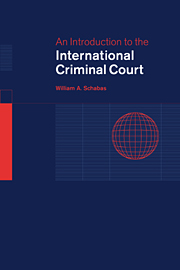Book contents
- Frontmatter
- Contents
- Preface
- List of abbreviations
- 1 Creation of the Court
- 2 Crimes prosecuted by the Court
- 3 Jurisdiction and admissibility
- 4 General principles of criminal law
- 5 Investigation and pre-trial procedure
- 6 Trial and appeal
- 7 Punishment and the rights of victims
- 8 Structure and administration of the Court
- Appendices
- Bibliography
- Index
8 - Structure and administration of the Court
Published online by Cambridge University Press: 05 June 2012
- Frontmatter
- Contents
- Preface
- List of abbreviations
- 1 Creation of the Court
- 2 Crimes prosecuted by the Court
- 3 Jurisdiction and admissibility
- 4 General principles of criminal law
- 5 Investigation and pre-trial procedure
- 6 Trial and appeal
- 7 Punishment and the rights of victims
- 8 Structure and administration of the Court
- Appendices
- Bibliography
- Index
Summary
The seat of the Court is The Hague, but it may sit elsewhere if it considers this desirable. The Netherlands was the only State to offer its services, despite rumours that circulated before and during the Diplomatic Conference about Rome, Lyon and Nuremberg as possible candidates. The Hague is already the seat of the International Court of Justice as well as of the ad hoc Tribunal for the Former Yugoslavia and other international judicial organizations. Its candidacy must have seemed so unbeatable to possible competitors that they declined even to throw their hats into the ring. As part of the preparatory process for coming into force of the Rome Statute, a ‘headquarters agreement’ is to be negotiated with the Netherlands.
The International Criminal Court is a new and independent international organization. The Court is formally distinct from the United Nations. Nevertheless, the United Nations has played a seminal role in its creation, and continues to fund the process of establishment of the Court. Its Security Council has the right to refer cases to the Court. The precise relationship between the two organizations is to be defined in an agreement that must also be finalized before the Rome Statute comes into force.
The International Criminal Court is composed of four ‘organs’: the Presidency, the Divisions, the Office of the Prosecutor and the Registry. There are three Divisions, the Appeals Division, the Trial Division and the Pre-Trial Division.
- Type
- Chapter
- Information
- An Introduction to the International Criminal Court , pp. 151 - 164Publisher: Cambridge University PressPrint publication year: 2001



